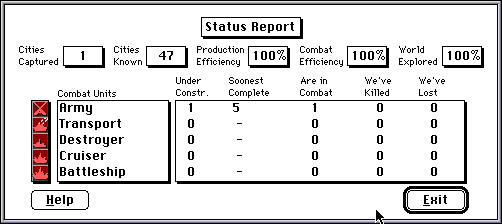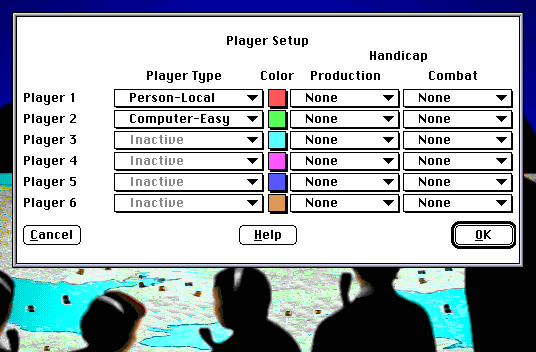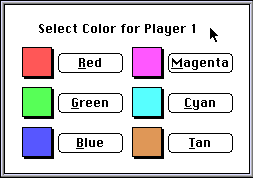
In 1994, Paul came across a strategy game called Empire Deluxe. It was based on an earlier game that pre-dated (and almost certainly influenced) Strategic Conquest. It included some features that we had proposed independently, and others that had not occurred to us.
Paul took notes on the game and attached them to our correspondence as a series of documents and screenshots. Following is a consolidation of those notes.
![]()
Piece Descriptions
Land Units
Land units are the only units that can capture cities.Infantry
Infantry are capable of creating airbases.Armor
It is important to note that when defending against shore bombardment and Bomber attacks, Armor has no advantage over Infantry. They take up twice as much space on Transports as Infantry. Armor cannot enter mountains. If an undamaged armor unit takes a city, it will immediately produce an Infantry unit in that city. They are also capable of creating airbases.Airbase
Airbases are the only units in the game that are not produced directly by cities. They are created by an Infantry or Armor unit that has been given the "Unload" order. Their primary use is as a place to land and refuel air units. Airbases can hold up to 8 air units (Fighters and Bombers) at any one given time, but may hold no other unit types. [This statement conflicts with the "Hold Capacity Unlimited" designation in the table - PRN.]Air Units
They can fly over any terrain square except for non-friendly cities. Unlike other units, air units must always move their maximum allotment of movement. Even if they sit still the entire turn, they are still assumed to have moved their maximum movement. An air unit that flies over a friendly city, Airbase, or Carrier automatically lands and ends its turn if it can.Fighter
Fighters can fly over, but not end their turn on, friendly units.Bomber
Sea Units
Sea Units can enter water and friendly city squares.Transport
Transports start with a hold capacity of 6; i.e., 6 Infantry or 3 Armor [or some combination thereof? - PRN]. If they are damaged, their hold capacity is reduced by two for every increment of damage taken. If the number of units on board exceed its holding capacity, the excess units are eliminated.Destroyer
Submarine
Cruiser
Battleship
Carrier
Carriers can hold up to 8 Fighters at any one time. Each increment of damage inflicted on a Carrier reduces the number of Fighters it can carry by 1. Any excess Fighters over that amount at the time the damage is taken are eliminated.Attack and Defense
| Piece | Move | Damage | Shot Damage | Attack | Defense |
|---|---|---|---|---|---|
| Infantry | 1 | 1 | 1 | 2 | 21 |
| Armor | 22 | 2 | 1 | 2 | 23 |
| Airbase | 0 | 1 | 1 | NA | 24 |
| Fighter | 6 | 1 | 1 | 2 | 2 |
| Bomber | 4 | 1 | 2 | 25 | 2 |
| Transport | 2 | 3 | 1 | 1 | 1 |
| Destroyer | 3 | 3 | 1 | 26 | 2 |
| Sub | 2 | 2 | 3 | 27 | 1 |
| Cruiser | 2 | 8 | 2 | 28 | 2 |
| Battleship | 2 | 12 | 3 | 29 | 2 |
| Carrier | 2 | 8 | 1 | 1 | 2 |
1Infantry defend vs. shore bombardment at a defense rating of 1.
2Entering rough, forest, or river squares reduces an Armor's move to 1.
3Armor defend vs. shore bombardment at a defense rating of 1.
4If destroyed, all air units at the Airbase are destroyed with it.
5Bombers have an attack and defense rating of 1 when in battle against Fighters.
6Destroyers have an attack rating of 1 when attacking air units.
7Submarines have an attack rating of 1 when attacking air units.
8Cruisers have an attack rating of 1 when attacking air units.
9Battleships have an attack rating of 1 when attacking air units.
Damage - Amount of total shot damage a unit can take before being destroyed.
Shot Damage - Amount of damage a unit does each time it scores a hit.
Attack - The combat ability of an attacking unit. The ratio of attack to defense gives the odds of the average number of hits the attacker would score vs. the average number of hits the defender would score.
Defense - The combat ability of a defending unit.
![]()
Other Characteristics
| Piece | Hold Capacity | Sighting Range | Can't See | Shore Bombard | Range | Prod Time |
|---|---|---|---|---|---|---|
| Infantry | NA | 1 | Sub | No | NA | 6/5 |
| Armor | NA | 1 | Sub | No | NA | 12/10 |
| Airbase | Unlimited | 2 | NA | No | NA | NA |
| Fighter | NA | 2 | Sub | No | 18 | 12/10 |
| Bomber | NA | 2 | Sub | No | 24 | 12/10 |
| Transport | 6 Armies, 3 Armor | 1 | Sub | No | NA | 30/25 |
| Destroyer | NA | 1 | NA | No | NA | 24/20 |
| Sub | NA | 1 | Land, Air Units | No | NA | 24/20 |
| Cruiser | NA | 1 | NA | Yes | NA | 42/35 |
| Battleship | NA | 1 | NA | Yes | NA | 60/50 |
| Carrier | 8 Fighters | 1 | Sub | No | NA | 48/40 |
Sighting Range - The number of squares away at which a unit can see an enemy unit or unexplored terrain square.
Can't See - The types of unit that a particular unit cannot see, even if that unit is within sighting range.
Shore Bombard - Attacking a land unit using a Cruiser or Battleship. Land units have only half their normal defense factor when being shore bombarded. Ships using shore bombardment do not move into the defenderŐs square if they are victorious.
Range - The number of squares an air unit can move before it must land or the number of squares a unit has remaining from its move that turn.
Prod Time - The number of turns it takes to produce a particular type of unit in a city with a production efficiency of 100%. The first number is the number of turns it would take to produce that unit from scratch. The second number is the number of turns it would take to produce that unit if the city had just finished producing that exact same type of unit on that turn.
![]()
Terrain Types
| Type | Reduces Armor Movement To 1 | Impassable to Armor | Unit's Defense Improved1 |
|---|---|---|---|
| Clear | No | No | No |
| Rough | Yes | No | No |
| River | Yes | No | Yes |
| Forest | Yes | No | Yes |
| Mountain | No | Yes | Yes |
1Does not apply to attacks by Infantry.
![]()
Status Report

World Creation
Quoted and summarized from the section by that title in "Empire Deluxe - The Official Strategy Guide". See Screenshot of Typical Empire Map.The computer makes two very important initial decisions before building a world. The artificial intelligence randomly decides the two crucial world-building variables: its wetness and its roughness.
Wetness primarily regulates the ratio of ocean squares to land squares on the finished map. It also affects the number of rivers that will be placed on the map, and, the larger the wetness variable, the greater will be the amount of forest squares on the map.
Roughness controls abrupt the land-to-ocean transition will be. Lower roughness will create larger, smoother continents. A higher roughness variable increases the chances that the landscape will be painted with plenty of mountainous, rough, and forest terrain when the world is being created.
High Points and Low Points
Once the wetness and roughness variables have been determined by the computer, it "builds a world of altitudes," according to programmer Mark Baldwin. The computer takes every square of the flat, two dimensional map and gives it a number representing a third, vertical dimension.Initially, these altitude numbers are all randomized.
The number of pushes made by these pattern blocks [not described - PRN], and how weak or strong each push will be, varies according to the predetermined roughness factor. Continental and oceanic patterns are then added to the world to give it a continuity that simulates natural plate tectonics.
Just Add Water
After the above alterations have been made to the altitude map, it rains - big time. The map fills the lowest-numbered-altitude squares with water until the right percentage of them becomes ocean terrain. This will always include the row of squares next to each defined map edge (giving ships a great deal of peripheral mobility). After the seas are thus formed, the roughness factor is rechecked. At this point, the highest-altitude squares become mountains while the second-highest tier of squares becomes rough terrain.Rivers are created next and are, naturally, tied to wetness. These rivers are created by the computer randomly placing the head of each river on land and then flowing it downhill, converting mountain and rough squares along its path until it hits an ocean square.
Forests are placed in a fairly random pattern, being tied to both roughness and wetness variables. However, when placing forests, the computer shows a bit of favoritism for certain squares. Basically, a random clear-terrain space is selected and the computer decides if it should become a forest or not. Each nonclear, nonocean square next to the square selected for forest placement will increase the chance of a forest being placed there.
The Urban Jungle
Before placing any cities, the computer determines how many it will place on the map (the number being the lesser of the total number of map squares divided by 50 or the total number of land squares divided by 15). The computer places cities by checking the entire map and looking at every nonocean, nonmountain square and giving it a probability of being replaced by a city square. Continents (landmasses containing more than one land square) have four times the chance of receiving a city than a lone island square does.
The mountains won't have cities, so that the narrower mountain chains don't get broken up. Those mountains are supposed to be really rugged.
- Mark Baldwin
If the randomly selected square is a port location, or there is a port city already somewhere on its landmass, the square is selected automatically. If neither of these conditions is true, the city moves to a port location before it is placed. In other words, the first city on any landmass will be a port (this is crucial to keeping the artificial opponents from getting confused when they play).
Before selecting the next square to be placed, all the squares within a five-square radius of a newly-placed city have their probability reduced in the next-city-square-placement lottery. Adjacent squares have their city-site-selection odds greatly reduced (making adjacent city squares highly improbable), while at the extreme range of five squares the reduction is nominal. These effects are cumulative should multiple cities be within five squares of another square eligible for city placement.
![]()
Miscellaneous Play Details
Unlike Strategic Conquest, pieces inside a city do not contribute to its defense. Further, they are destroyed if the city is captured. This seems to me to be a design mistake. Curiously, pieces in a city are allowed to attack.Enemy pieces are not allowed in friendly cities (or, I believe, in neutral cities).
Air units end their turn when they touch a base. I don't like this rule.
In general, the winning piece in a battle takes over the place of the loser. This is not true wherever it doesn't make sense, e.g., when a sea piece attacks a land piece.
Other than in cities and on transports and carriers, only one piece is allowed per square.
Empire Deluxe (optionally) plays music to prompt the player to move. Different sounds are associated with Air, Sea, and Land pieces. This sound cue is both effective and, over time, grating. In the balance, I currently favor the idea.
The size of the default world (yes, the world size is customizable) in the Standard game is such that it seems quite possible to complete the game without exploring much of the map. Another way to look at this: the exploration and expansion phases of the game can extend much past 100 turns. This can change one's strategy quite a bit. The size is the world is a distinct plus.
On investigation, I see that the default world size is 60x100 (versus Strategic Conquest's 60x80). The length of the exploration and expansion phases is so much greater in ED than in SC that some other factor must be involved. The largest possible world size with ED is 150x200, truly huge.
Discovered cities appear on the map in the state they are found if they are not revisited. It's necessary to "fly-by" a city occasionally to see if it has been taken by the enemy. Similarly, each sighted enemy unit appears on the map where it was last seen, with its icon darkened to distinguish it as a "last known location." After three turns, or if the square is revisited and found unoccupied, the icon disappears.
Contrary to a previous report, Empire Deluxe provides multiple levels of difficulty, both for production and for combat. The attached pictures show the Player Setup dialog box and the Player Color Selection dialog box:


Choices for Player Type are:
- Person - Local
- Person - Play by Mail
- Computer - Easy
- Computer - Standard
- Computer - Expert
- Remote - AppleTalk
- Modem Port
- Printer Port
- GeoPort
"This option allows you to handicap that player by increasing the amount of time it takes that player to produce units, thus making it harder for that player to win. The choices range from None (no effect on production) to Impossible (triple the normal production times)."
Actual choices from the application are:
- Advantage-3
- Advantage-2
- Advantage-1
- None
- Slight
- Moderate
- Average
- High
- Severe
- Extreme
"Same as above, but affecting combat probabilities."